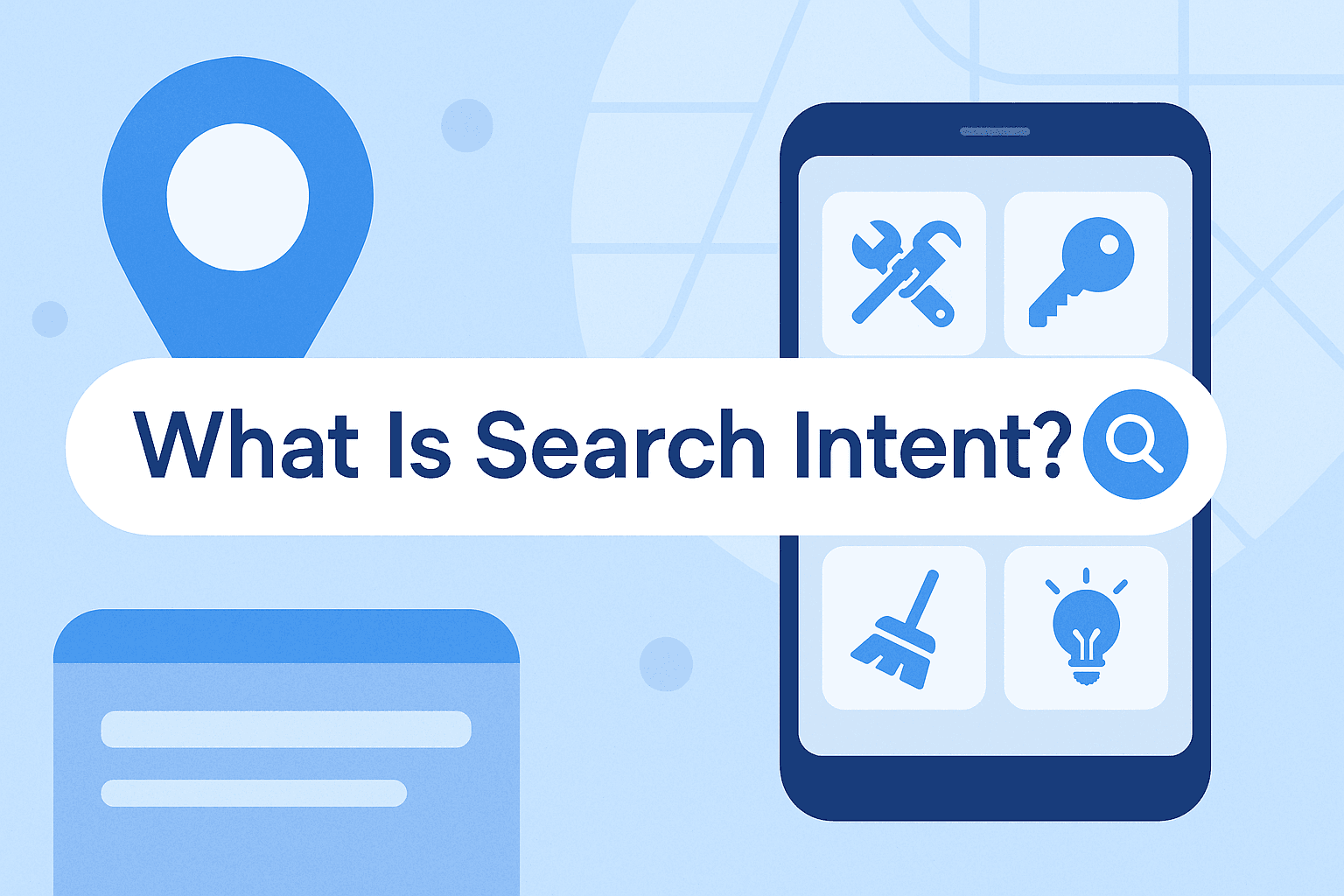All right, let’s get real for a second. You ever been elbow-deep in a home emergency, pipe bursts, keys locked in the car, carpet smells like your dog exploded, and you Google something like “plumber near me”? Boom. That right there is search intent in action.
What Search Intent Actually Means
Search intent, or “what people actually want when they type stuff into Google,” is basically the difference between someone curious and someone ready to throw money at you to fix their mess.
A lot of folks think it’s just “informational” versus “buying.” Nope. It’s more like: are they looking for info, options, someone to hire, or your actual business? And when you toss in local stuff, like city names, “near me,” or “open now”, it gets even more specific.
Let’s break down what kinds of intent local service businesses deal with, and I’ll keep it plain.
| Intent Type | What It Means Locally | Example Query | What You Should Publish |
|---|---|---|---|
| Informational (“Know”) | They’re trying to figure something out before spending money. | “Why is water leaking under my sink?” | Blog post: explain the cause, give DIY steps, then gently pitch your services. |
| Commercial (“Compare”) | They’re shopping around, checking who’s best. | “Best electrician in Pasadena” | Comparison or review page showing what makes you better. |
| Transactional (“Do / Hire”) | They’re ready to call now. | “Emergency plumber near me” | Strong service page with phone number, hours, map, and “Book Now.” |
| Navigational (“Brand”) | They already know who they want. | “Smith’s Locksmith Santa Monica” | Your name, map, hours, contact. Just make it easy to reach you. |
Obviously, local intent matters. If someone types “plumber near me,” they’re not hoping for results in another state. They want the guy who can show up before the carpet mold sets in.
How Real People Actually Search
Let’s look at a few real searches and unpack what’s going on behind the keyboard.
Example 1: “plumber near me”
Intent: Transactional + Local
Mindset: “Help me. I need a pro… now.”
Your move: Have a service page with a clear “Call Now” button, your phone number big enough to read from across the room, and your Google Business Profile all polished up.
Example 2: “how to fix clogged kitchen drain”
Intent: Informational
Mindset: “Can I fix this myself before I break something?”
Your move: Post a short guide showing quick fixes, but end with: “If this doesn’t work, call us.” You’ll catch them right before they give up and reach for the phone.
Example 3: “best carpet cleaner in [City]”
Intent: Commercial + Local
Mindset: “Convince me you’re worth it.”
Your move: Create a page comparing services, reviews, and prices. Add local reviews and schema markup to make Google’s life easier.
Example 4: “locksmith open now”
Intent: Transactional + Urgent
Mindset: “It’s 2 a.m. and I’m locked out.”
Your move: Make sure your website screams “OPEN 24/7” and has a click-to-call button. Google loves showing those “open now” businesses right at the top when someone’s stranded.
How to Actually Match Content to Intent
- Reverse-engineer Google.
Type your target keyword into Google. See what ranks… blogs? maps? service pages? That’s your clue. - Don’t mash everything into one page.
Keep blogs for info, service pages for sales. Link them together so people can move down the funnel naturally. And while you’re at it, make sure those pages use keywords in the right spots so Google actually pays attention. Check out our guide to SEO keyword placement - Make it local.
Drop your city name in your headings and title tags. Keep your name, address, and phone (NAP) consistent everywhere. Reviews help too, especially ones that use keywords like “emergency plumber.” If you want to dive deeper into building local trust and visibility, take a look at The Complete Guide to Local SEO Services. - Add structured data.
Use LocalBusiness and Review schema so Google knows who you are and what you do. - Target urgent searches.
Have specific pages for “emergency,” “same-day,” and “after hours.” People literally search for those phrases when the world’s on fire. - Cover every service area.
If you cover multiple ZIPs or towns, make local landing pages for each. One-size-fits-all pages just don’t convert. - Link everything smartly.
Big city page links to smaller service pages. Smaller pages link to blog posts. Think of it like a plumbing system, everything should connect.
The Proof’s in the Numbers
Here’s what’s happened when businesses actually did all this:
- A California plumbing company saw a 240% jump in calls and 304% more clicks in 90 days after they tightened up their map listings and local SEO.
- A U.K. plumber got 65% of calls from local searches after fixing their Google profile and building service area pages.
- Agencies agree: if you can land in the “Local Pack” (those top 3 map spots), your conversion rates skyrocket compared to regular organic results. Want to show up in that Local Pack more often? Read our guide on how to rank higher in Google Maps and local search results
What should you track?
- Clicks and calls from map results.
- Form submissions on local pages.
- Rankings for “near me” searches.
- Impressions from your Google Business Profile.
- Review count (and how often new ones appear).
Quick Outline for Marketers
If you’re planning content, here’s the cheat sheet:
- Define search intent.
- Explain how local intent changes it.
- Give real examples (plumbers, locksmiths, cleaners).
- Lay out best practices.
- Show case studies and metrics.
- Demonstrate how to classify intent via SERP research.
- Plan content around different intents.
Bottom line? Search intent isn’t some buzzword, it’s just understanding what people really mean when they type something into Google. You don’t need a PhD in SEO to get it right. You just need to listen to what folks are actually asking for and build your content like you’re answering them directly.
That’s how you get clicks, calls, and customers… and maybe even a night off without the phone ringing at 2 a.m.

